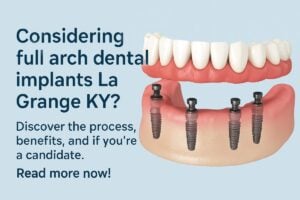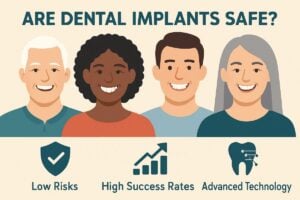If you’ve wondered “can you get teeth replaced,” the short answer is yes. Modern dentistry offers reliable ways to replace one tooth, several teeth, or an entire mouth. This post explains why teeth are lost, the main replacement choices today, who makes a good candidate, and how to pick the option that fits your health, budget, and smile goals.
Common reasons people need tooth replacement
Teeth are lost or need removal for many reasons: deep decay or failed root canals, injury or trauma, congenital missing teeth, advanced gum disease, or long-term tooth loss. Missing teeth change how you chew and speak, can cause nearby teeth to shift, and lead to bone loss in the jaw over time. Replacing teeth restores function and helps protect oral health.
Modern tooth replacement options
Dental implants
A dental implant is a titanium post placed into the jaw, topped with an abutment and crown. Implants can replace a single tooth, support multiple crowns, or anchor bridges and dentures. They preserve bone, feel and act like natural teeth, and often last many years when cared for. Good candidates have healthy gums and enough bone, or can have bone grafting to qualify.
Fixed bridges
A bridge replaces one or more teeth by using the neighboring teeth for support. Bridges are quicker than implants and avoid surgery, but they require reshaping adjacent teeth and may not stop bone loss where the tooth is missing. Typical lifespan is 7–15 years with good care.
Removable partial and full dentures
Dentures replace many or all teeth and come as traditional removable devices or implant‑retained versions. They are usually the most affordable option and can restore chewing and appearance quickly. Removable dentures require daily cleaning and periodic adjustments; implant‑retained dentures offer more stability and bone support.
All‑on‑4 / full‑arch implant solutions
All‑on‑4 and similar full‑arch options use several implants to support a full fixed prosthesis, often placed and loaded quickly. These are ideal for patients missing most teeth and who want a more permanent, natural-feeling solution. Recovery includes healing time and follow-up adjustments.
How to know which option fits you
Choose based on oral and overall health, jawbone volume, smoking and medical conditions like diabetes, budget, timeline, and desired look and feel. A dentist will evaluate your mouth, take X-rays or a 3D scan, and discuss pros and cons for your situation. Some patients prefer the permanence of implants; others choose bridges or dentures for cost or speed.
What to expect during the process
Consultation and imaging
Expect an oral exam, X-rays or CBCT 3D imaging, and a clear treatment plan with timelines and costs. Digital scans help plan precise placement for implants and restorations.
Treatment stages and recovery
Non‑surgical options like bridges move faster. Implant treatment may require surgery, healing time, and temporary restorations. Follow-up visits check healing and fit; most people return to normal activities within days to weeks, with full healing over months.
Costs, insurance, and financing
Costs vary widely by option and complexity. Insurance may cover parts of crowns or bridges but often limits implant coverage. Many practices offer payment plans or third‑party financing to spread costs.
Questions to ask your dentist
Ask: Am I a candidate for implants? Will I need bone grafting? What are success rates and risks? How long will restorations last? What sedation options do you offer?
Why advanced technology and experience matter
Digital scans, 3D imaging, same‑day milling, and in‑house implant labs improve accuracy, comfort, and speed. Experienced clinicians using these tools can plan more predictable outcomes and reduce surprises.
About the practice and next steps
Dr. Bradley Harmon of Harmon Dental Center combines advanced training and memberships in leading dental organizations with state‑of‑the‑art tools—Primescan digital scanning, CBCT 3D imaging, an on‑site implant lab, Primemill milling, 3D printing, and a surgical suite—to provide personalized implant and restorative care. Schedule a consultation to review your options and get a clear plan for replacing missing teeth.






